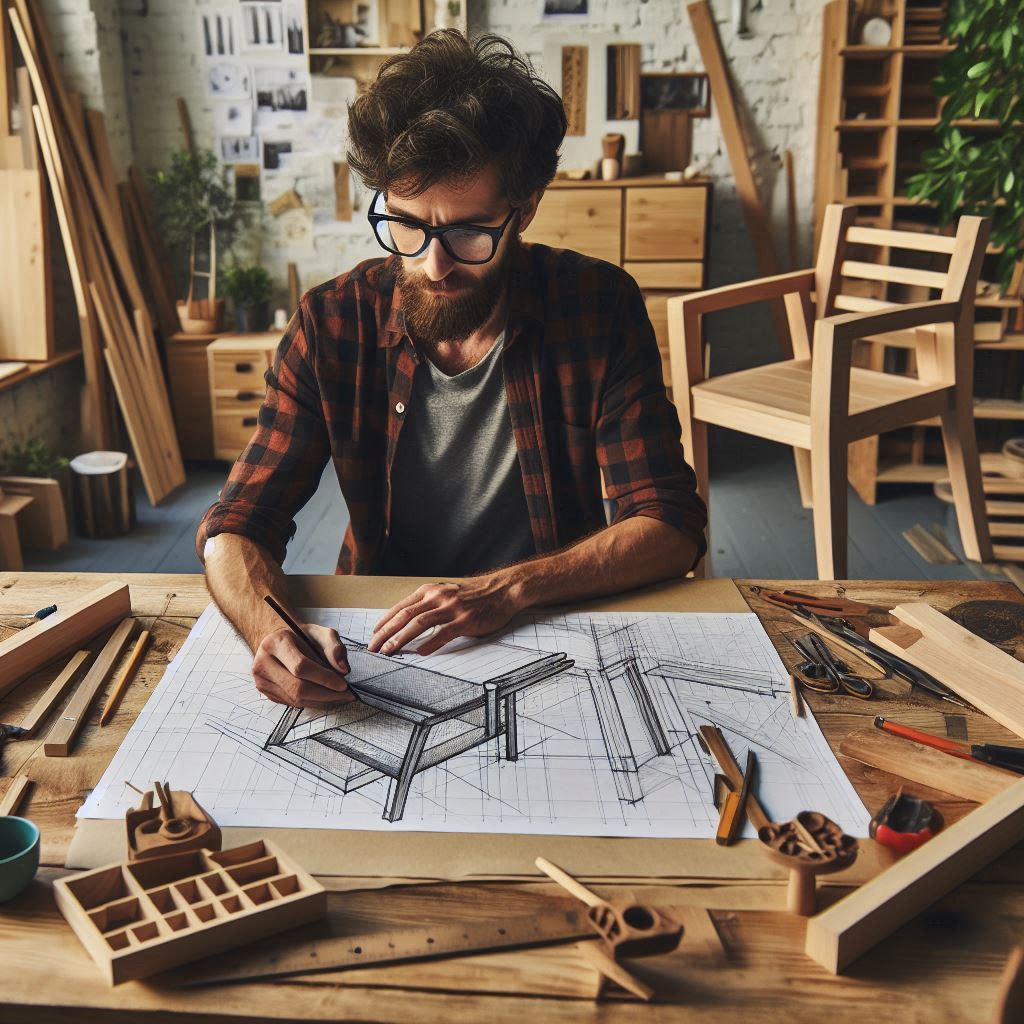Introduction
Wood remains a timeless material in furniture design.
Its natural beauty and versatility appeal to both designers and consumers.
Working with wood allows furniture designers to create unique, durable pieces that stand the test of time.
Understanding wood properties is crucial for successful design.
Different types of wood exhibit varying strengths, grains, and finishes.
Designers must learn how to choose the right wood for each project.
Successful woodworking requires a blend of skills and knowledge.
Designers must develop proficiency in hand tools and power tools.
Knowing how to properly measure, cut, and join wood is essential.
Additionally, understanding wood finishing techniques enhances the overall aesthetic of the furniture.
Designers should also learn about sustainable sourcing practices to minimize environmental impact.
A solid foundation in woodworking principles empowers designers to innovate.
By mastering these skills, they can bring their creative visions to life.
Furniture design is not just about aesthetics; it also involves functionality and durability.
With the right knowledge and skills, designers can produce beautiful, lasting furniture that resonates with clients.
Ultimately, working with wood enriches the design process and elevates the final product.
Understanding Different Types of Wood
Importance of Selecting the Right Type of Wood for Different Furniture Pieces
Selecting the right type of wood is crucial for furniture designers.
Each wood type has unique characteristics that influence the final product.
Understanding these differences enhances both functionality and aesthetics.
This knowledge also helps in making informed design choices.
The right wood ensures that the furniture meets client expectations and stands the test of time.
Characteristics of Popular Wood Types such as Oak, Pine, and Mahogany
Oak
Oak is a popular choice among furniture designers.
It is known for its strength and durability.
This hardwood features a prominent grain, which adds visual interest to furniture.
Oak resists warping and wear, making it suitable for tables and chairs.
Its natural light color can be stained to achieve various looks.
Additionally, oak is versatile and works well in both traditional and contemporary designs.
Pine
Pine, another commonly used wood, is softer than oak.
This softness makes pine easier to work with, especially for intricate designs.
Pine has a light color and can showcase a rustic charm.
Its knots and grains give character to the furniture.
However, pine is less durable than oak, so it’s best for pieces that won’t endure heavy use.
Many designers use pine for children‘s furniture and casual seating.
Mahogany
Mahogany is a classic choice for high-end furniture.
This hardwood boasts a rich, reddish-brown hue that deepens over time.
Mahogany has a straight, fine grain, providing a smooth finish.
Its stability and resistance to swelling make it ideal for humid environments.
Many designers prefer mahogany for crafting cabinets and fine furniture.
Its luxurious appearance often elevates the perceived value of the final product.
Understanding wood types also involves recognizing their ecological impact.
Sustainable sourcing is crucial in today‘s furniture industry.
Choosing responsibly harvested woods can reduce environmental harm.
Designers can contribute to sustainability by opting for reclaimed or certified woods.
This choice not only benefits the planet but also appeals to environmentally conscious consumers.
Moreover, different woods affect the furniture’s cost and longevity.
Oak and mahogany tend to be more expensive due to their durability.
In contrast, pine offers an affordable option for budget-conscious projects.
Selecting the right wood type also influences the overall design concept.
Some woods lend themselves well to modern styles, while others suit traditional designs.
Finish options vary with wood types, affecting the final appearance.
Oak absorbs stains well, allowing for diverse color choices.
Pine, being softer, may require careful finishing to avoid scratches.
Mahogany holds finishes beautifully, resulting in a glossy look that enhances its richness.
Designers must consider these factors to ensure a polished and appealing final product.
In review, understanding different types of wood is essential for furniture designers.
Each type contributes unique characteristics, affecting both aesthetics and functionality.
By prioritizing the right wood, designers create timeless pieces that meet clients’ needs and expectations.
Read: Historic Costume Design Inspirations
Tools and Equipment Needed
Furniture designers need a solid set of tools and equipment for woodworking.
These tools not only enhance creativity but also improve efficiency.
Below is a list of essential tools every furniture designer should have, along with tips for maintaining and sharpening them.
Essential Tools for Woodworking
- Table Saw: A table saw is essential for making precise cuts in large sheets of wood. It provides stability and accuracy.
- Circular Saw: This portable saw is ideal for making straight cuts in lumber.
It‘s useful for both rough cuts and detailed work. - Miter Saw: A miter saw allows you to make angled cuts easily. It‘s excellent for framing, trim work, and furniture joints.
- Band Saw: This tool excels at cutting curves and intricate shapes.
It‘s perfect for crafting unique furniture designs. - Drill: A drill is vital for making holes and driving screws.
Choose a cordless model for added flexibility and convenience. - Router: A router helps shape edges and create decorative patterns.
It‘s essential for adding details to furniture pieces. - Sander: Sanding is crucial for a smooth finish.
An orbital sander is versatile and effective for various surfaces. - Chisels: Chisels are indispensable for fine details and joinery.
Use them to clean up edges and create joints. - Clamps: Clamps hold pieces together while glue sets.
They come in various sizes and types, so have several on hand. - Measuring Tools: Accurate measurements are crucial in woodworking.
A tape measure, square, and level will ensure precision.
Maintaining and Sharpening Tools
Proper maintenance and sharpening are key to optimal performance.
Dull tools can lead to poor results and increased effort.
Here are some tips to keep your tools in top condition.
- Clean Your Tools Regularly: After each use, clean your tools to remove dust and resin.
Use a soft brush or cloth to avoid scratches. - Lubricate Moving Parts: Apply lubricant to moving parts of tools.
This prevents rust and keeps them operating smoothly. - Store Tools Properly: Store your tools in a dry place.
Use toolboxes or cabinets to prevent damage and keep them organized. - Sharpen Blades and Bits: Regularly sharpen blades and drill bits. Use a sharpening stone or file for accurate edges.
- Inspect Tools Frequently: Check tools for wear and damage.
Replace worn or broken parts promptly to ensure safety and performance. - Use the Right Tool for the Job: Selecting the right tool minimizes wear and maximizes efficiency.
Each tool has its specific function. - Follow Manufacturer‘s Instructions: Adhere to the guidelines provided by manufacturers.
This ensures that you maintain tools correctly and safely.
By investing in the right tools and maintaining them properly, furniture designers can achieve remarkable results.
With sharp and well-maintained equipment, creativity flows more freely, allowing for innovative designs in woodworking.
Read: Breaking Down Iconic Movie Costumes
Design Considerations
Factors to Consider When Designing Furniture Pieces
When designing furniture pieces, several crucial factors come into play.
First, consider the style you wish to convey.
Different styles, such as modern, rustic, or traditional, appeal to various audiences.
Aligning your design with a specific style helps ensure your piece resonates with potential buyers.
Functionality is another vital consideration.
Each furniture piece must serve a purpose while fitting seamlessly into its environment.
Think about how users will interact with the piece.
For instance, a coffee table should offer a comfortable height for guests to reach.
In contrast, a desk must provide ample workspace without feeling cramped.
Size is equally important in furniture design.
Take accurate measurements of the intended space before starting your design.
Oversized furniture can overwhelm a room, while undersized pieces may feel out of place.
Strive for balance and proportion in your designs.
A well-proportioned piece will enhance the overall aesthetic of the space.
Importance of Creating Detailed Sketches and Plans Before Starting a Project
Creating detailed sketches and plans is crucial before starting a project.
Sketching allows you to visualize your ideas and refine them early in the process.
Start with basic outlines, then gradually add details like textures and finishes.
A sketch serves as a reference, helping you stay on track throughout the design and building stages.
Your sketches should include dimensions and materials.
This level of detail will guide you in selecting appropriate materials for construction.
It also allows you to identify potential issues before they arise.
For instance, you might realize that a particular material won’t support the intended weight.
Plans should also outline the construction process.
Detailing each step ensures you follow a logical sequence during assembly.
This preparation minimizes errors and saves time.
By anticipating challenges, you can adjust your plans accordingly, leading to smoother execution.
Additionally, consider ergonomic factors in your designs.
Ensure that chairs, tables, and other pieces are comfortable for users.
Pay attention to seat height, back support, and overall usability.
Ergonomically designed furniture enhances user experience and promotes health.
Lastly, don‘t overlook the importance of aesthetics.
Color, finish, and texture play significant roles in furniture design.
Choose a color palette that complements the intended environment.
Incorporating diverse textures can create visual interest and enhance the overall appeal of the piece.
In essence, successful furniture design involves a careful balance of style, functionality, size, and planning.
Thorough sketches and detailed plans provide a solid foundation for your projects.
By considering these factors, you can create beautiful, functional pieces that meet the needs of users.
Read: Networking Events for Costume Designers

Joinery Techniques
Joinery techniques play a crucial role in furniture design.
They provide strength and durability to your creations.
Understanding these methods will enhance the quality of your work.
In this section, we will overview common joinery techniques and offer tips for choosing the right one.
Overview of common joinery techniques such as dovetail, mortise and tenon, and butt joints
Dovetail Joints
Dovetail joints are popular for their strength and aesthetic appeal.
They feature interlocking tails and pins that create a strong bond.
Woodworkers often use them for drawer construction and cabinetry.
When crafting a piece with visible joints, dovetails provide a beautiful finish.
However, they require precision and time to execute properly.
Mortise and Tenon Joints
Mortise and tenon joints are among the strongest joinery methods.
This technique consists of a mortise hole in one piece and a tenon that fits into it.
Woodworkers frequently use it for framing and attaching legs to tables.
Mortise and tenon joints can withstand stress, making them ideal for structural connections.
They are versatile and can be adjusted in size for different furniture designs.
Butt Joints
Butt joints are the simplest and most common joinery technique.
They involve joining two pieces of wood at their ends.
While butt joints are easy to create, they may not be as strong as other methods.
To enhance their strength, consider using adhesive or reinforcing them with screws.
Butt joints are best suited for applications where strength is not the primary concern.
Choosing the Right Joinery Technique
Selecting the right joinery technique is essential for the furniture‘s functionality and aesthetics.
Consider the furniture piece’s purpose before deciding.
For example, use dovetail joints for drawers where strength and appearance matter.
Mortise and tenon joints work well for tables and chairs that bear weight.
Also, assess the visibility of the joints.
If the joints are exposed, choose a technique that enhances the piece’s overall look.
Dovetail joints provide an elegant finish, while butt joints may require additional finishing techniques.
Furthermore, think about the complexity of the joinery.
Some techniques, like dovetails, require advanced skills and tools.
If you are a beginner, start with simpler methods, such as butt joints.
As your skills improve, gradually incorporate more complex techniques into your designs.
Finally, consider the type of wood you are using.
Different woods have varying densities and strengths.
Softer woods may not hold certain joints as well as harder woods.
Always test your chosen joint on scrap pieces before applying it to your project.
In general, understanding common joinery techniques will elevate your furniture design skills.
Dovetail, mortise and tenon, and butt joints each have unique advantages.
By choosing the right technique for your projects, you will create beautiful, functional pieces that stand the test of time.
Finishing Touches
Finishing is crucial in furniture design.
It enhances the appearance and durability of your pieces.
Different finishing options can transform your work from ordinary to extraordinary.
Here, we explore staining, painting, and varnishing to help you choose the best method.
Explanation of different finishing options such as staining, painting, and varnishing
Staining
Staining allows the natural beauty of the wood to shine through.
It enhances the grain while adding color.
You can choose from oil-based or water-based stains.
Oil-based stains offer rich color and durability.
They take longer to dry, so plan accordingly.
Water-based stains dry quickly and are easy to clean.
However, they may require more applications to achieve the desired depth.
When applying stain, always test it on a scrap piece of wood first.
This helps you see how the final color will look.
Use a clean cloth or brush to apply the stain evenly.
Work in small sections to prevent streaks or blotches.
Allow the stain to penetrate the wood for a few minutes, then wipe off the excess.
For a deeper color, apply additional coats after the first layer dries.
Transform Your Career Today
Unlock a personalized career strategy that drives real results. Get tailored advice and a roadmap designed just for you.
Start NowPainting
Painting furniture can offer bold color and unique designs.
It‘s a great way to personalize your pieces.
Start by choosing a high-quality paint suitable for wood.
Acrylic or latex paints are popular options for furniture.
They are easy to work with and come in many colors.
Before painting, prepare the surface properly.
Sand the wood to create a smooth base.
Clean off any dust with a damp cloth.
Use a primer to ensure better paint adhesion and durability.
After priming, apply the paint using a brush or roller.
Work in thin, even coats to avoid drips.
Allow each coat to dry completely before applying the next one.
This ensures a smooth and even finish.
Varnishing
Varnishing provides a protective layer and enhances the wood’s natural look.
It can add shine and depth to your furniture.
Varnish comes in different sheens, from matte to glossy.
Choose a finish that complements your design.
To achieve a smooth varnish finish, start with a clean, sanded surface.
Apply the varnish with a high-quality brush or foam applicator.
Use long, even strokes to avoid brush marks.
Allow the varnish to dry according to the manufacturer‘s instructions.
Lightly sand between coats with fine-grit sandpaper.
This creates a smooth surface and helps the next coat adhere better.
Regardless of the finishing option you choose, patience is key.
Take your time with each step for the best results.
A well-finished piece not only looks professional but also enhances the overall quality of your work.
Remember, the finishing touches can make all the difference in your furniture design.
So invest time and effort into perfecting this final step for stunning results.
Read: Famous Costume Designers in Hollywood
Safety Precautions
Safety should always be a priority when working with wood.
Furniture designers often face various hazards in their craft.
By understanding the importance of protective gear and safe tool usage, designers can minimize risks and create a safer workspace.
Importance of Wearing Protective Gear
Wearing protective gear is essential for preventing injuries.
Goggles protect your eyes from dust and flying debris.
Always choose goggles that fit well and provide adequate coverage.
Gloves are equally important; they shield your hands from splinters and sharp edges.
Select gloves that offer a good grip while allowing dexterity.
Avoid wearing loose clothing that could get caught in machinery.
Ear protection is also vital when working with loud tools, so use earmuffs or earplugs.
Tips on Using Tools Safely
When using tools, always adhere to safety guidelines.
Familiarize yourself with each tool’s operation manual before use.
Understanding the tool’s capabilities and limitations can help prevent accidents.
Inspect your tools regularly for any damage.
Replace any worn-out parts before starting your project.
Keep your workspace organized to avoid tripping hazards.
Ensure that all tools and materials are stored properly when not in use.
Maintain a clean work area to prevent accidents and improve efficiency.
Removing clutter reduces distractions and helps you stay focused.
Always use the right tool for the job.
Each tool has a specific purpose; using the wrong one increases the risk of accidents.
Ensure you have the necessary tools readily available before starting your project.
This will prevent you from rushing or improvising mid-task, which can lead to injuries.
Properly handle tools to ensure your safety.
Always use both hands when operating power tools.
This provides better control and stability.
Stand firmly with your feet shoulder-width apart to maintain balance.
Avoid overreaching, which can lead to accidents.
If a tool becomes stuck, turn it off and disconnect it before attempting to free it.
Practice good posture while working to reduce strain.
Keep your back straight and bend at the knees when lifting heavy materials.
This prevents back injuries and promotes overall well-being.
Take regular breaks to avoid fatigue, which can impair your judgment and coordination.
Be aware of your surroundings while working.
Keep children and pets away from your workspace to prevent accidents.
Inform others in your area about your activities to minimize distractions.
This creates a safer environment for everyone involved.
Basically, prioritizing safety is vital for furniture designers.
By wearing protective gear and following tool safety guidelines, you can prevent accidents and injuries.
Stay vigilant, practice safe habits, and create a secure workspace.
Remember, your safety is just as important as your creative process.
Troubleshooting Common Issues
Woodworking is a rewarding craft, but it comes with its challenges.
Even experienced furniture designers face common mistakes.
By identifying these issues early, you can prevent costly setbacks.
Here are some common woodworking mistakes and tips for troubleshooting them.
Common Woodworking Mistakes and How to Avoid Them
One frequent mistake is choosing the wrong type of wood.
Different woods behave differently under various conditions.
Always research the properties of your chosen material before starting.
For instance, hardwoods like oak and maple are more durable than softwoods like pine.
Using the right wood for your project ensures longevity and stability.
Another common issue is poor measuring and cutting techniques.
Inaccurate measurements lead to ill-fitting joints and wasted materials.
Always double-check your measurements before cutting.
Use a high-quality tape measure and a reliable square.
Practice using a miter saw for precision cuts, and consider using a stop block to ensure uniform lengths.
Tips on troubleshooting issues such as warped wood or uneven joints
Fixing Warped Wood
Warped wood can ruin the aesthetic of your project.
Humidity changes can cause wood to swell or warp.
To fix warped wood, first, assess the severity of the warp.
For slight warps, you can try to flatten the wood by applying moisture.
Dampen a cloth and place it over the warp, then apply heat with an iron.
This method often relaxes the fibers, allowing them to return to their original shape.
For more severe warps, you might need to use a moisture meter.
This tool measures the moisture content of the wood.
If the wood is too dry, consider placing it in a humid environment.
Conversely, if it‘s too moist, let it acclimate in a drier area.
Addressing Uneven Joints
Uneven joints can compromise the strength and appearance of your furniture.
Ensure that the surfaces of your joints are flat and clean before assembly.
Use a chisel or sandpaper to smooth out any rough edges.
When joining pieces, apply adequate glue and clamp them securely.
This step ensures even pressure across the joint.
If your joints still appear uneven after drying, you can fix them.
Carefully sand down the high spots to create a level surface.
Use a random orbital sander for the best results.
Finally, finish the joint with wood filler to conceal imperfections.
Final Thoughts
Troubleshooting common woodworking issues is essential for successful furniture design.
By understanding and addressing mistakes early, you can enhance your skills.
Remember to choose the right wood, measure accurately, and fix warps and joints effectively.
With practice and patience, you will become a more proficient furniture designer.
Embrace these challenges and continue creating beautiful, functional pieces.
Resources for Further Learning
Aspiring furniture designers can benefit greatly from various resources that enhance their skills and knowledge.
Books, websites, and videos offer valuable insights into woodworking techniques, design principles, and materials.
Additionally, workshops and courses provide hands-on experience that sharpens craftsmanship and creativity.
Suggestions for books, websites, and videos for aspiring furniture designers
Books for Inspiration and Learning
Start by exploring influential books that delve into furniture design.
“The Complete Manual of Woodworking” by Albert Jackson, David Day, and Simon Jennings is a comprehensive guide that covers essential tools, materials, and techniques for woodworking.
“The Furniture Bible” by Christophe Pourny is another excellent resource discussing restoration techniques and the history of furniture design.
Consider reading “Designing Furniture” by Eric McCullough, which focuses on design principles and practical tips for creating unique pieces.
“Woodworking Basics” by Peter Korn offers an introduction to woodworking fundamentals.
This book emphasizes essential skills for beginners and experienced woodworkers alike.
Websites for Online Learning
Numerous websites provide valuable resources for furniture designers.
FineWoodworking.com is a leading site offering articles, videos, and forums that feature expert advice on woodworking techniques, tools, and project ideas.
Another excellent resource is The Wood Whisperer, which provides tutorials, product reviews, and a supportive community for woodworkers.
YouTube is an invaluable platform for visual learners.
Many talented woodworkers share their expertise through video tutorials.
Channels like “Woodworking for Mere Mortals” and “The Samurai Carpenter” provide practical advice and project ideas.
Follow these channels to stay inspired and learn new skills.
Videos for Visual Learning
Videos are particularly helpful for grasping woodworking techniques.
Look for video series that cover specific topics like joinery or finishing techniques.
The “Woodworkers Guild of America” offers a wealth of instructional videos.
These videos cover everything from basic skills to advanced techniques, making them suitable for all skill levels.
Workshops and Courses for Hands-On Experience
In addition to online resources, consider enrolling in workshops or courses.
Local community colleges and craft schools often offer woodworking classes.
These classes range from introductory courses to advanced design workshops.
They provide hands-on experience with expert instructors, which can be invaluable for skill development.
Organizations like the American Association of Woodturners often host workshops.
Attending these workshops connects you with other woodworkers and industry professionals.
Networking can lead to collaboration opportunities and valuable insights.
Generally, aspiring furniture designers should explore various resources for further learning.
Books, websites, and videos provide essential knowledge and inspiration.
Workshops and courses offer hands-on experience to hone your woodworking skills.
By utilizing these resources, you can enhance your design abilities and create stunning furniture pieces.
Find Out More: Career Path: Storyboard Artist in Film and TV
Conclusion
In this blog post, we explored essential tips for furniture designers working with wood.
Understanding wood types helps you choose the best materials.
Learning proper cutting techniques ensures precision in your designs.
Incorporating joinery methods strengthens your furniture and enhances durability.
Finishing techniques not only beautify your pieces but also protect them from damage.
Always remember the importance of safety measures when working with tools.
Experimenting with different woodworking techniques can lead to unique creations.
Don’t hesitate to explore new styles and innovations in your designs.
Practice is crucial in mastering woodworking skills.
Each project offers valuable lessons that improve your craftsmanship.
As you gain experience, you will discover your personal design style.
Embrace the learning process and allow your creativity to flourish.
We encourage you to dive into woodworking and experiment with various techniques.
Take risks and learn from mistakes; they often lead to the best outcomes.
By practicing regularly, you will enhance your furniture design skills and create beautiful, functional pieces.
Enjoy the journey, and let your passion for woodworking inspire your designs.
Showcase Your Business Today
Reach thousands of readers actively exploring professional services. Publish your business profile and grow your audience now.
Publish Now[E-Books for Sale]
The Big Book of 500 High-Paying Jobs in America: Unlock Your Earning Potential
$19.99 • 500 High-Paying Jobs • 330 pages
Explore 500 high-paying jobs in America and learn how to boost your career, earn more, and achieve success!
See All 500 High-Paying Jobs of this E-Book
1001 Professions Without a Degree: High-Paying American Jobs You Can Start Now
$19.99 • 1001 Professions Without a Degree • 174 pages
Discover 1001 high-paying jobs without a degree! Unlock career tips, skills, and success strategies for just $19.99!




